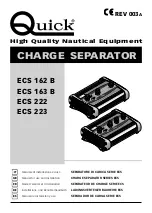
Basic Principles
75
Cat. No. 01022940
Appendix B Basic Principles
Reverse Osmosis
In order to understand reverse osmosis, we must first define osmosis. Osmosis is the passage of a liquid through a
semi-permeable membrane. A semi-permeable membrane is a membrane which allows one component of a solution to
pass through it and not the others. In osmosis, there is a tendency for a liquid to go from an area of less concentration to
an area of more concentration through a semi-permeable membrane. Figure 56 shows the osmotic process.
Figure 56.
Osmotic process.
If sufficient pressure is applied to the concentrated solution, reverse osmosis will take place. The pressure causes a flow
through the semi-permeable membrane into the dilute solution. The semi-permeable membrane acts as a barrier to most
ions and many other contaminants and does not allow them to pass through into the dilute solution. When applied to
water, this means that the product water has a reduced total dissolved solids content as a result of the passage of water
molecules through the membrane while the mineral ions are rejected. See Figure 57.
Figure 57.
Effect of pressure on reverse osmosis.
Содержание M1 Series
Страница 83: ...Notes 79 Cat No 01022940 Notes ...
Страница 84: ......






































